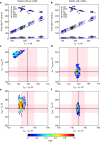Geophysical evidence for an enriched molten silicate layer above Mars's core
- PMID: 37880437
- PMCID: PMC10600000
- DOI: 10.1038/s41586-023-06601-8
Geophysical evidence for an enriched molten silicate layer above Mars's core
Erratum in
-
Author Correction: Geophysical evidence for an enriched molten silicate layer above Mars's core.Nature. 2024 Jan;625(7995):E13. doi: 10.1038/s41586-023-06930-8. Nature. 2024. PMID: 38168625 Free PMC article. No abstract available.
Abstract
The detection of deep reflected S waves on Mars inferred a core size of 1,830 ± 40 km (ref. 1), requiring light-element contents that are incompatible with experimental petrological constraints. This estimate assumes a compositionally homogeneous Martian mantle, at odds with recent measurements of anomalously slow propagating P waves diffracted along the core-mantle boundary2. An alternative hypothesis is that Mars's mantle is heterogeneous as a consequence of an early magma ocean that solidified to form a basal layer enriched in iron and heat-producing elements. Such enrichment results in the formation of a molten silicate layer above the core, overlain by a partially molten layer3. Here we show that this structure is compatible with all geophysical data, notably (1) deep reflected and diffracted mantle seismic phases, (2) weak shear attenuation at seismic frequency and (3) Mars's dissipative nature at Phobos tides. The core size in this scenario is 1,650 ± 20 km, implying a density of 6.5 g cm-3, 5-8% larger than previous seismic estimates, and can be explained by fewer, and less abundant, alloying light elements than previously required, in amounts compatible with experimental and cosmochemical constraints. Finally, the layered mantle structure requires external sources to generate the magnetic signatures recorded in Mars's crust.
© 2023. The Author(s).
Conflict of interest statement
The authors declare no competing interests.
Figures




References
-
- Samuel H, et al. The thermo-chemical evolution of Mars with a strongly stratified mantle. J. Geophys. Res.-Planet. 2021;126:e2020JE006613. doi: 10.1029/2020JE006613. - DOI
-
- Stevenson, D.J. in Origin of the Earth (eds Newsom H. E. & Jones J. H.) 231–249 (Oxford Univ. Press, 1990).
-
- Solomatov, V.S. in Treatise on Geophysics (ed. Schubert G.) 81–104 (Elsevier, 2015).
LinkOut - more resources
Full Text Sources
Miscellaneous

